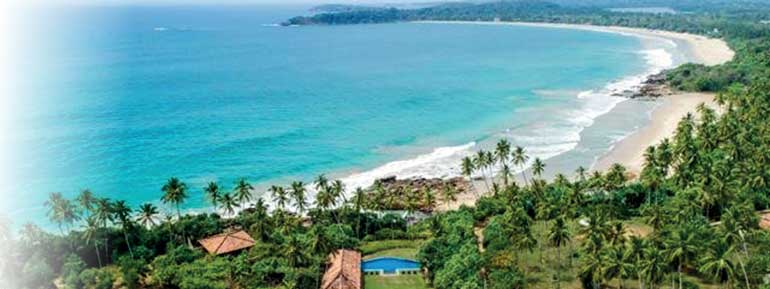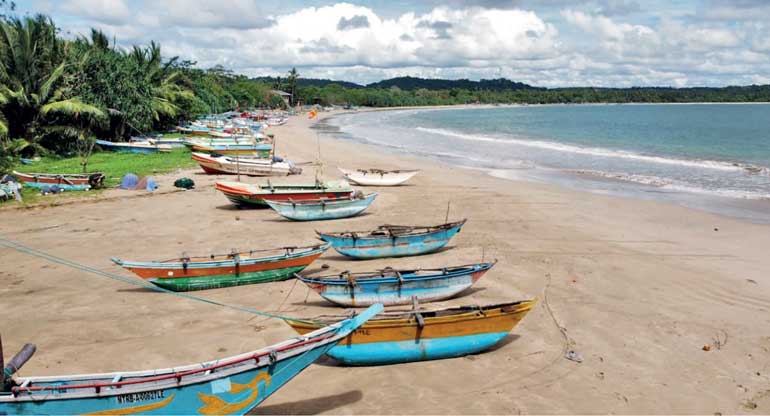Friday Mar 07, 2025
Friday Mar 07, 2025
Wednesday, 2 March 2022 00:00 - - {{hitsCtrl.values.hits}}

Mawella Bay

Broad beaches for the parking of the Oru

Mawella Bay, named amongst the top 10 most beautiful beaches in Sri Lanka by Lonely Planet, is under severe threat of destruction due to unplanned coastal constructions.
The Sri Lanka Tourism Development Authority (SLTDA) is in a lone fight against the Coast Conservation Department (CCD) and the Fisheries Ministry to stop this massive environmental disaster, which if it goes ahead, will give clear signals across the world that Sri Lanka does not subscribe to sustainable tourism and environmental practices.
Mawella Tourism Association (MTA), which has a membership of the investors of the beach properties in the Mawella Bay, says that all their efforts to make the authorities understand that such badly planned constructions would be a detriment to the investors and also give a very bad signal across the globe, has gone unheeded.
Lonely Planet, which has existed for almost 50 years and is probably the most used and trusted guide across the world, advising hundreds of millions of travellers of all budgets every year, describes the bay as mesmerising. “Mawella is a mesmerising yet little-known south coast beach. Its 2 km (1.2 mile) crescent-shaped bay is backed by just a handful of boutique hotels, villas and simple bungalows, basking in vast palm-shaded grounds. Despite being just 7 km (4.3 miles) from Tangalla, those in the know come here for a rare taste of southern escapism and plan to do very little at all. That said, the rolling waves are fun for body-boarding, and the long beach is super for break-of-dawn runs.”
“The proposed structures that might well spell the end for this beautiful beach, includes the 300 metres long stone anchorage which is already built and two offshore breakwaters which is said will mitigate erosion. However, there has been no scientific approach in the planning of these suddenly proposed structures, which may well seal the fate of this beautiful internationally lauded coastal stretch,” says a spokesperson for the Association.
An Environmental Impact Assessment (EIA), which is the best possible mechanism available under the law to ensure fair play, was not conducted in regard to the proposed hard structures. Despite Sri Lanka Tourism instructing the Fisheries Ministry and the CCD to consult stakeholders in this regard, it went unheeded. The two state agencies instead decided to go ahead with just an Initial Environmental Examination (IEE), which does not require stakeholder consultation.
The SLTDA has put the Fisheries Ministry and the CCD on notice in this regard stating that these constructions were not done with the consultation of all stakeholders.
Mawella Tourism Association says they have no confidence in the current design and plans of the CCD because the anchorage that has been built in the bay is faulty in design and the other plans for the breakwaters also are not being done in any scientific manner. Their views are backed by a coastal scientist who they consulted on this matter.
The consultant, Charitha Pattiaratchi, Professor of Coastal Oceanography at the University of Western Australia has said that the construction of the two 60 m offshore breakwaters is not recommended because they are being located in a region with high waves and current activity. “The region for the proposed breakwaters is a highly complex region in terms of hydrodynamics and sand transport. The breakwaters will retain sand in the lee which will interrupt the alongshore transport of sand. As the sand retained would be from regions along the ~1.5 km length of beach there is a strong probability of extreme erosion in other regions of the Bay,” says the Professor.
There have been many reports in the past done by experts on hard coastal structures in coastal areas with undesirable repercussions.
Kem Lowry of the University of Hawaii and H.J.M. Wickremeratne of the Coast Conservation Dept. who did a feasibility study on ‘Coastal Area Management in Sri Lanka’ presented a report in 1988, where a section on ‘Ill-designed Coastal Erosion Protection Structures’ refer to several reactive measures taken by the Coast Conservation Department (CCD). They state in their report that while these were probably done under public pressure to prevent erosion, they have without a doubt proved disastrous and some of the structures were built without any scientific understanding of the local coastal dynamics. The result was the ‘solution’ to prevent erosion in one area, causing considerable erosion to occur elsewhere.
A more recent research project carried out by the Asian Development Bank Institute (ADBI) in March 2021 titled, ‘Are coastal protective hard structures still applicable with respect to shoreline changes in Sri Lanka?’, refers to human influence on nature. It says the application of hard structures is least able to control coastal erosion in a large area because while it may be good for the site it is not helpful for adjacent areas. It says the environment will remain under its natural conditions as long as humans introduce no alterations.
Discover Kapruka, the leading online shopping platform in Sri Lanka, where you can conveniently send Gifts and Flowers to your loved ones for any event including Valentine ’s Day. Explore a wide range of popular Shopping Categories on Kapruka, including Toys, Groceries, Electronics, Birthday Cakes, Fruits, Chocolates, Flower Bouquets, Clothing, Watches, Lingerie, Gift Sets and Jewellery. Also if you’re interested in selling with Kapruka, Partner Central by Kapruka is the best solution to start with. Moreover, through Kapruka Global Shop, you can also enjoy the convenience of purchasing products from renowned platforms like Amazon and eBay and have them delivered to Sri Lanka.
Discover Kapruka, the leading online shopping platform in Sri Lanka, where you can conveniently send Gifts and Flowers to your loved ones for any event including Valentine ’s Day. Explore a wide range of popular Shopping Categories on Kapruka, including Toys, Groceries, Electronics, Birthday Cakes, Fruits, Chocolates, Flower Bouquets, Clothing, Watches, Lingerie, Gift Sets and Jewellery. Also if you’re interested in selling with Kapruka, Partner Central by Kapruka is the best solution to start with. Moreover, through Kapruka Global Shop, you can also enjoy the convenience of purchasing products from renowned platforms like Amazon and eBay and have them delivered to Sri Lanka.